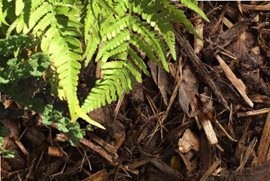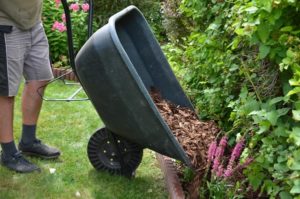what is mulching?
 A mulch is a loose material, either biodegradable or non-biodegradable, that is used to cover the surface of the soil or compost. Mulching is the act of applying the mulch to an area.
A mulch is a loose material, either biodegradable or non-biodegradable, that is used to cover the surface of the soil or compost. Mulching is the act of applying the mulch to an area.
biodegradable mulch or non-biodegradable mulch?
Typical biodegradable mulches include bark, wood chips, straw and compost, which will all break down over a period of time and provide additional nutrients to the soil, whilst also improving the structure when it is dug in and replaced.
Non-biodegradable mulches are products such as rubber chips, gravel and slate chippings. These are longer lasting and can be used as decorative mulches, but won’t break down into the soil or provide any nutrients.
When to apply mulch
 Mulching can be carried out at any time of year, but the ideal times are mid to late spring and autumn, because at these times of year the soil won’t be too dry or cold. Mulch shouldn’t be applied to frozen ground.
Mulching can be carried out at any time of year, but the ideal times are mid to late spring and autumn, because at these times of year the soil won’t be too dry or cold. Mulch shouldn’t be applied to frozen ground.
In spring/summer, mulch will help to prevent the area drying out, deter some pests, can prevent fruit and vegetables coming into contact with the soil and suppress weeds; in the autumn, applying a mulch will protect the roots of the plants from frost damage as well as enhancing the appearance of the area year-round.
How to apply mulch
Tools required:
- Shovel
- Wheelbarrow
- Gloves
- Rake (optional)
Step 1
Before you start, the area should be cleared of any weeds.
Step 2
Calculate how much mulch is needed. The depth should be at least 50mm x length x width of the area, which will give you the volume to order. You can use our mulch calculator to help.
Step 3
If the area is being planted up, you may want to consider applying a weed membrane between the soil and the mulch that can be cut through when placing plants; a permeable membrane is better as this allows water to pass through it.
Step 4
Whichever mulch is used, for optimum results it should be applied over moist soil which isn’t frozen. Most mulches can be easily spread by hand or using a shovel, you can then use a standard rake or the tip of the shovel to level it out.
Step 5
Care should be taken when placing mulch around woody stems or trunks, to ensure that it doesn’t touch them, because this can cause them to soften and become vulnerable to disease and rot. Once you are happy with the level of mulch, check the plants to make sure they aren’t smothered.
How often should mulch be reapplied?
This can vary depending upon the mulch, whether it is lightweight, biodegradable, non-biodegradable, the environment, etc.
Non-biodegradable mulch should only require topping up as you notice the depth starting to reduce, but the old mulch shouldn’t be dug into the soil because it adds no benefit to the soil or plants, won’t break down and can leave you with a stony soil.
Biodegradable mulch will break down over time depending upon the environment it’s in. It can be dug into the soil because when it breaks down it adds nutrients, which can improve the health and structure of the soil. In most cases, an annual top up is fine, but you may wish to replenish through the year if you notice areas of soil starting to show through the mulch.
If you would like to keep up to date with Hallstone advice, news and special offers, please sign up to our Newsletter.